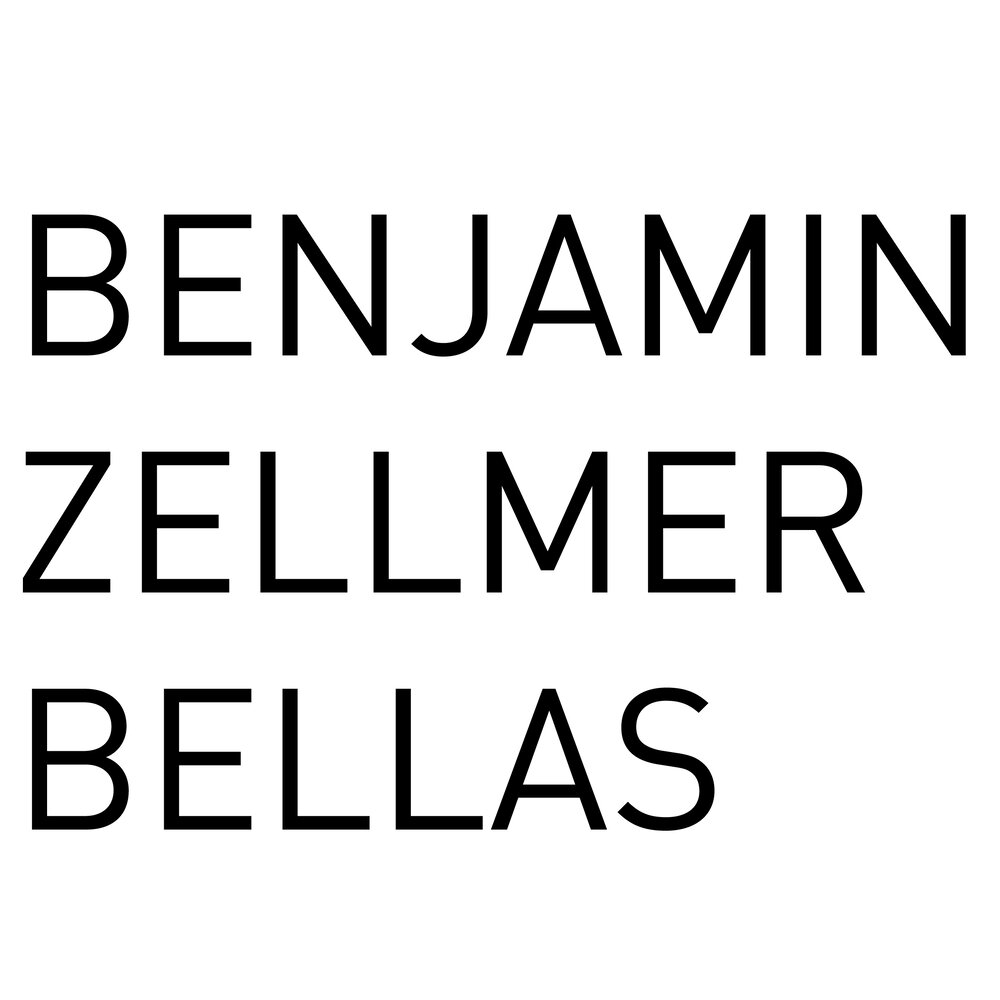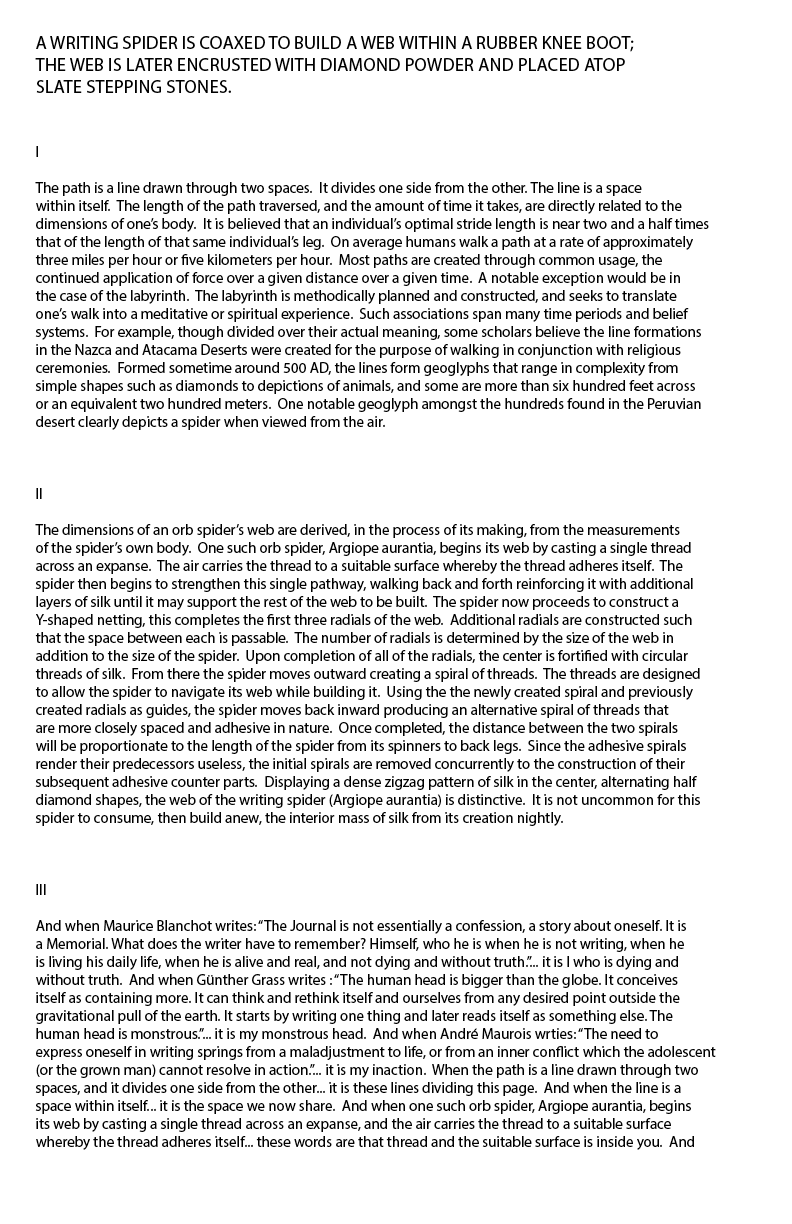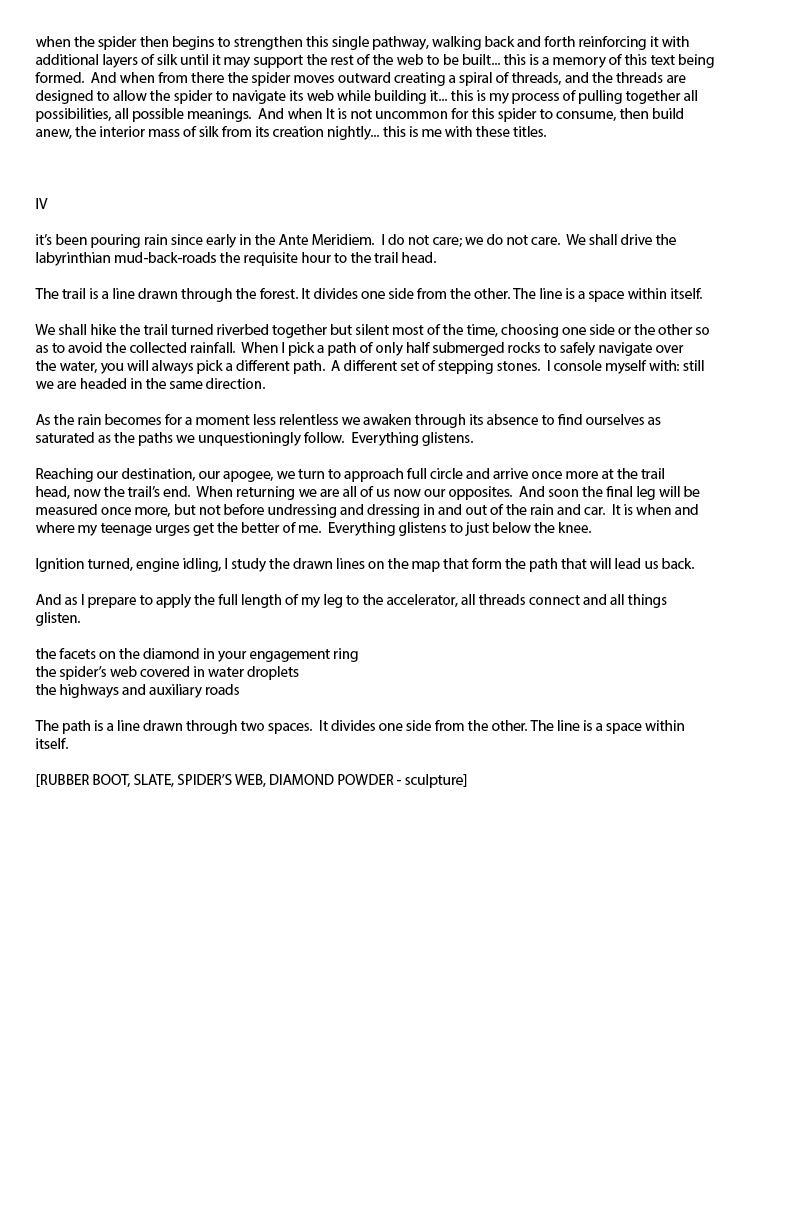A WRITING SPIDER IS COAXED TO BUILD A WEB WITHIN A RUBBER KNEE BOOT; THE WEB IS LATER ENCRUSTED WITH DIAMOND POWDER AND PLACED ATOP SLATE STEPPING STONES.
I
The path is a line drawn through two spaces. It divides one side from the other. The line is a space within itself. The length of the path traversed, and the amount of time it takes, are directly related to the dimensions of one’s body. It is believed that an individual’s optimal stride length is near two and a half times that of the length of that same individual’s leg. On average humans walk a path at a rate of approximately three miles per hour or five kilometers per hour. Most paths are created through common usage, the continued application of force over a given distance over a given time. A notable exception would be in the case of the labyrinth. The labyrinth is methodically planned and constructed, and seeks to translate one’s walk into a meditative or spiritual experience. Such associations span many time periods and belief systems. For example, though divided over their actual meaning, some scholars believe the line formations in the Nazca and Atacama Deserts were created for the purpose of walking in conjunction with religious ceremonies. Formed sometime around 500 AD, the lines form geoglyphs that range in complexity from simple shapes such as diamonds to depictions of animals, and some are more than six hundred feet across or an equivalent two hundred meters. One notable geoglyph amongst the hundreds found in the Peruvian desert clearly depicts a spider when viewed from the air.
II
The dimensions of an orb spider’s web are derived, in the process of its making, from the measurements of the spider’s own body. One such orb spider, Argiope aurantia, begins its web by casting a single thread across an expanse. The air carries the thread to a suitable surface whereby the thread adheres itself. The spider then begins to strengthen this single pathway, walking back and forth reinforcing it with additional layers of silk until it may support the rest of the web to be built. The spider now proceeds to construct a Y-shaped netting, this completes the first three radials of the web. Additional radials are constructed such that the space between each is passable. The number of radials is determined by the size of the web in addition to the size of the spider. Upon completion of all of the radials, the center is fortified with circular threads of silk. From there the spider moves outward creating a spiral of threads. The threads are designed to allow the spider to navigate its web while building it. Using the the newly created spiral and previously created radials as guides, the spider moves back inward producing an alternative spiral of threads that are more closely spaced and adhesive in nature. Once completed, the distance between the two spirals will be proportionate to the length of the spider from its spinners to back legs. Since the adhesive spirals render their predecessors useless, the initial spirals are removed concurrently to the construction of their subsequent adhesive counter parts. Displaying a dense zigzag pattern of silk in the center, alternating half diamond shapes, the web of the writing spider (Argiope aurantia) is distinctive. It is not uncommon for this spider to consume, then build anew, the interior mass of silk from its creation nightly.
III
And when Maurice Blanchot writes: “The Journal is not essentially a confession, a story about oneself. It is a Memorial. What does the writer have to remember? Himself, who he is when he is not writing, when he is living his daily life, when he is alive and real, and not dying and without truth.”... it is I who is dying and without truth. And when Günther Grass writes : “The human head is bigger than the globe. It conceives itself as containing more. It can think and rethink itself and ourselves from any desired point outside the gravitational pull of the earth. It starts by writing one thing and later reads itself as something else. The human head is monstrous.”... it is my monstrous head. And when André Maurois wrties: “The need to express oneself in writing springs from a maladjustment to life, or from an inner conflict which the adolescent (or the grown man) cannot resolve in action.”... it is my inaction. When the path is a line drawn through two spaces, and it divides one side from the other... it is these lines dividing this page. And when the line is a space within itself... it is the space we now share. And when one such orb spider, Argiope aurantia, begins its web by casting a single thread across an expanse, and the air carries the thread to a suitable surface whereby the thread adheres itself... these words are that thread and the suitable surface is inside you. And when the spider then begins to strengthen this single pathway, walking back and forth reinforcing it with additional layers of silk until it may support the rest of the web to be built... this is a memory of this text being formed. And when from there the spider moves outward creating a spiral of threads, and the threads are designed to allow the spider to navigate its web while building it... this is my process of pulling together all possibilities, all possible meanings. And when It is not uncommon for this spider to consume, then build anew, the interior mass of silk from its creation nightly... this is me with these titles.
IV
it’s been pouring rain since early in the Ante Meridiem. I do not care; we do not care. We shall drive the labyrinthian mud-back-roads the requisite hour to the trail head.
The trail is a line drawn through the forest. It divides one side from the other. The line is a space within itself.
We shall hike the trail turned riverbed together but silent most of the time, choosing one side or the other so as to avoid the collected rainfall. When I pick a path of only half submerged rocks to safely navigate over the water, you will always pick a different path. A different set of stepping stones. I console myself with: still we are headed in the same direction.
As the rain becomes for a moment less relentless we awaken through its absence to find ourselves as saturated as the paths we unquestioningly follow. Everything glistens.
Reaching our destination, our apogee, we turn to approach full circle and arrive once more at the trail head, now the trail’s end. When returning we are all of us now our opposites. And soon the final leg will be measured once more, but not before undressing and dressing in and out of the rain and car. It is when and where my teenage urges get the better of me. Everything glistens to just below the knee.
Ignition turned, engine idling, I study the drawn lines on the map that form the path that will lead us back.
And as I prepare to apply the full length of my leg to the accelerator, all threads connect and all things glisten.
the facets on the diamond in your engagement ring
the spider’s web covered in water droplets
the highways and auxiliary roads
The path is a line drawn through two spaces. It divides one side from the other. The line is a space within itself.
[RUBBER BOOT, SLATE, SPIDER’S WEB, DIAMOND POWDER - sculpture]
2011






